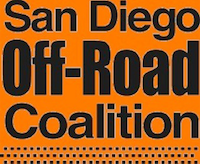I would like to comment on the Grand View Travel Management Plan Environmental Assessment on behalf of the San Diego Off-Road Coalition. Some of our members travel to Idaho to ride these routes and we are quite disturbed by the massive trail closures proposed in this plan.
The plan talks about soil erosion as a justification for closing routes and uses the K factor of soil as a determining factor. While K factor is an important part, it is not the entire story for soil erosion. The Universal Soil Loss Equation predicts the average annual soil loss “A” per unit area. The equation is A = R x K x L x S x C x P. The plan area has an average rainfall of 11.5″. This is so little that, together with the other factors, means that erosion is minor. To use K factor as a justification for closing routes is unjustified. The BLM will need to show the complete Universal Soil Loss Equation for each part of each route closed by this. Why is this even a factor? Please explain. Many of the trails in the TMA are narrow sandy water channels. When it rains enough for the water to flow, the sand will move downstream, whether or not dirt bikes have been through there. Dirt bike use in these channels will have no effect on K factor of soil and should not be used as a justification to close routes. We look at the Grand Canyon with awe, yet we forget it was created by erosion. So what if a few dirt bikes cause a little erosion?
In the background section of the EA, it mentions: “In Owyhee County, Idaho, alone, OHV registration increased 258% between 1998 and 2014.” So, with a large increase in OHV registrations near the management area, the BLM find it necessary to close a large percentage of routes? The BLM should be looking at ways to increase the number of routes and mileage to accommodate the influx of users, not restrict them. The best way to reduce impacts to routes is to increase the number and length of routes, not reduce them. On the topic of increased users, reducing access will have the effect of increasing environmental impacts as well as reducing safety. The BLM needs to not close these routes, but instead work to designate more new routes.
If voting for an alternative is useful, we vote for alternative “A”, as it has the most trail mileage. While that may not be useful, the BLM must create another alternative that has much more route mileage. With more users and fewer routes, the impacts on open routes may become unacceptable, resulting in more closures. This circle of action may result in all routes being closed. This does not reflect the multiple use mandate at all and must be redesigned. The BLM must reverse this closure process and manage the routes currently there, as well as open new routes.
Special status species is an interesting excuse to close routes. Special status species are not threatened or endangered and should not be used as an excuse to close routes. The Endangered Species Act has lists of threatened and endangered species. The plan and alternatives must list what threatened or endangered species are causing what routes to be closed. Evidence of the routes(s) causing direct harm to listed species must be cited in the alternatives. Species noted as “special status” have no legal justification and should not be used to justify closing of any routes. All alternatives must be reconfigured to remove special status species from justifying route closures.
From page 45 of the plan: “The effects of route density on wildlife vary by species; however, areas with route density greater than 2.0 mi/mi2 exceed thresholds for many terrestrial wildlife species (Trombulak and Frissell 2000; Wisdom et al. 2004) and 1.0 mi/mi2 has been determined to be the maximum threshold for a naturally functioning landscape containing sustained populations of large mammals (Forman and Hersperger 1996).” The plan cites (Forman and Hersperger 1996) as justifying the goal to have at maximum 1 mile of route per square mile of land. What the plan does not get right is that study looks at PAVED highways, while the plan is looking at DIRT singletrack trails usually one foot wide in the TMA. So the fact that the BLM is using a study that looks at paved highways to justify route density in the travel management area is wrong. The alternatives must be rewritten to remove this justification.
Alternative D is by far the second-best alternative, but it grossly ignores the need for routes for recreation. None of the alternatives (other than A) are adequate and should be redrawn to account for the above comments. Using Forman and Hersperger 1996 to justify closing routes was a crime and should be litigated out of your office. Using K Factor without completing the Universal Soil Loss Equation for each route and showing on the EA is unprofessional. Proposing to close a high percentage of routes while stating that OHV registrations are way up is grossly inconsistent with the facts as well as the BLM’s multiple use mandate. BLM, please reformulate the alternatives using good science and showing your work. These alternatives are unfair to off-highway vehicle users and have been created in an unprofessional manner.
